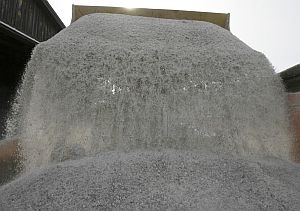 (Host) Public works directors have stored up a large supply of road salt to avoid the kind of shortages that left roads slippery last winter.
(Host) Public works directors have stored up a large supply of road salt to avoid the kind of shortages that left roads slippery last winter.
But, as VPR’s Ross Sneyd reports, it will cost more to keep highways ice-free this year.
(Sneyd) Most of us think about winter driving only when the temperatures dip and the first hard frost settles in the valleys.
Highway crews don’t have that luxury. They have to fill their salt sheds well in advance of the first snowflakes.
They thought they’d done that last year. But by the middle of an especially snowy winter, they were running out.
(Goodkind) “It seemed like after New Year’s, it was always a situation of constant shortage. We were all looking for different sources to get salt from.”
(Sneyd) Steve Goodkind is public works director in Burlington.
The city couldn’t get resupplied regularly and it nearly ran out of salt several times.
So did towns around Vermont – and around the Northeast.
Goodkind doesn’t want that to happen in Burlington again. He ordered his crews to clean out unused sheds to make room for extra salt for this winter.
(Goodkind) "I think not only Burlington but almost everyone has realized we shouldn’t rely on a system that we can call up and there’s going to be salt there all the time. We all have to do a better job of stockpiling even though we’ve never had this problem before. So in our case right now we have eight, almost 900 tons of salt in our yard and most towns that can do it are doing something like that.”
(Sneyd) That’s three or four times what Burlington usually has on hand at any given time. It should get the city through maybe a third of the winter.
Some public works departments tried to work together. They pooled their resources and sought a single bid in the hope they’d have more clout with a larger order.
The state Transportation Agency has already filled all of its sheds, except for one that’s under construction.
VTrans now has 90,000 tons on hand.
And according to deputy operations director Scott Rogers, that supply has cost the state a lot more.
(Rogers) “So we saw price increases around the state from 14 percent to 24 percent. And in talking with neighboring states and others around the country, I think we did pretty well. We heard of other states experiencing price increases in the 30 percent range, so we were quite pleased with the prices we got.”
(Sneyd) The salt industry says prices were driven largely by higher fuel costs. The industry also has struggled this summer to meet demand.
States and cities across the Northeast and Midwest ran short last year. They’ve increased their orders this year to avoid that again. Illinois, for example, boosted its order by one-third – more than 400,000 tons.
That’s increased the pressure on distribution networks – and driven prices even higher.
For VPR News, I’m Ross Sneyd.
AP Photo/Toby Talbot